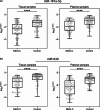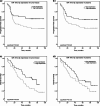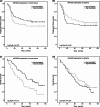Potential of miR-181a-5p and miR-630 as clinical biomarkers in NSCLC
- PMID: 37697308
- PMCID: PMC10496384
- DOI: 10.1186/s12885-023-11365-5
Potential of miR-181a-5p and miR-630 as clinical biomarkers in NSCLC
Abstract
Background: The development of drug resistance and high mortality rates are the major problems observed in non-small cell lung cancer (NSCLC). Biomarkers indicating and predicting disease development towards these unfavorable directions are therefore on high demand. Many studies have demonstrated that changes in miRNAs expression may be associated with a response to treatment and disease prognosis, thus suggesting its potential biomarker value for a broad spectrum of clinical applications. The aim of the present study was to investigate the expression level of miR-181a-5p, miR-630, and its targets in NSCLC tumor tissue and plasma samples; and to analyze its association with NSCLC patient's response to treatment and disease prognosis.
Methods: The study was performed in 89 paired tissue specimens and plasma samples obtained from NSCLC patients who underwent surgical treatment at the Department of Thoracic Surgery and Oncology of the National Cancer Institute. Analysis of miR-181a-5p and miR-630 expression was performed by qRT-PCR using TaqMan miRNA specific primers. Whereas BCL2, LMO3, PTEN, SNAI2, WIF1 expression levels were identified with KAPA SYBR FAST qPCR Kit. Each sample was examined in triplicate and calculated following the 2-ΔΔCt method. When the p-value was less than 0.05, the differences were considered statistically significant.
Results: It was found that miR-181a-5p and miR-630 expression levels in NSCLC tissue and plasma samples were significantly decreased compared with control samples. Moreover, patients with low miR-181a-5p expression in tumor tissue and plasma had longer PFS rates than those with high miRNA expression. Decreased miR-630 expression in tumor was statistically significantly associated with better NSCLC patients' OS. In addition, the expression of miR-181a-5p, as well as miR-630 in tumor tissue, are the statistically significant variables for NSCLC patients' OS. Moreover, in NSCLC patient plasma samples circulating miR-181a-5p can be evaluated as significant independent prognostic factors for OS and PFS.
Conclusions: Our findings indicate the miR-181a-5p and miR-630 expression levels have the potential to prognose and predict and therefore improve the treatment individualization and the outcome of NSCLC patients. Circulating miR-181a-5p has the potential clinical value as a non-invasive biomarker for NSCLC.
Keywords: NSCLC; Non-invasive clinical biomarkers; Response to treatment; miR-181a-5p; miR-630.
© 2023. BioMed Central Ltd., part of Springer Nature.
Conflict of interest statement
The authors declare no competing interests.
Figures



Similar articles
-
Serum miR-1228-3p and miR-181a-5p as Noninvasive Biomarkers for Non-Small Cell Lung Cancer Diagnosis and Prognosis.Biomed Res Int. 2020 Jul 6;2020:9601876. doi: 10.1155/2020/9601876. eCollection 2020. Biomed Res Int. 2020. PMID: 32724822 Free PMC article.
-
Clinical evaluation of microRNA expression profiling in non small cell lung cancer.Lung Cancer. 2013 Sep;81(3):388-396. doi: 10.1016/j.lungcan.2013.05.007. Epub 2013 Jun 10. Lung Cancer. 2013. PMID: 23756108
-
Extracellular vesicles miR-574-5p and miR-181a-5p as prognostic markers in NSCLC patients treated with nivolumab.Clin Exp Med. 2024 Aug 6;24(1):182. doi: 10.1007/s10238-024-01427-8. Clin Exp Med. 2024. PMID: 39105937 Free PMC article.
-
Identification of differentially expressed circulating serum microRNA for the diagnosis and prognosis of Indian non-small cell lung cancer patients.Curr Probl Cancer. 2020 Aug;44(4):100540. doi: 10.1016/j.currproblcancer.2020.100540. Epub 2020 Jan 23. Curr Probl Cancer. 2020. PMID: 32007320 Review.
-
Prognostic Role of MicroRNAs in Human Non-Small-Cell Lung Cancer: A Systematic Review and Meta-Analysis.Dis Markers. 2018 Oct 21;2018:8309015. doi: 10.1155/2018/8309015. eCollection 2018. Dis Markers. 2018. PMID: 30538784 Free PMC article.
Cited by
-
MicroRNA-630: A potential guardian against inflammation in diabetic kidney disease.World J Diabetes. 2024 Sep 15;15(9):1837-1841. doi: 10.4239/wjd.v15.i9.1837. World J Diabetes. 2024. PMID: 39280181 Free PMC article.
-
Serum extracellular vesicle microRNAs as potential biomarkers to predict pembrolizumab response and prognosis in metastatic non-small cell lung cancer patients.Front Immunol. 2025 Jun 4;16:1540906. doi: 10.3389/fimmu.2025.1540906. eCollection 2025. Front Immunol. 2025. PMID: 40534853 Free PMC article.
-
Circulating cell-free and extracellular vesicles-derived microRNA as prognostic biomarkers in patients with early-stage NSCLC: results from RESTING study.J Exp Clin Cancer Res. 2024 Aug 22;43(1):241. doi: 10.1186/s13046-024-03156-y. J Exp Clin Cancer Res. 2024. PMID: 39169404 Free PMC article.
-
The Role of microRNAs in Lung Cancer: Mechanisms, Diagnostics and Therapeutic Potential.Int J Mol Sci. 2025 Apr 15;26(8):3736. doi: 10.3390/ijms26083736. Int J Mol Sci. 2025. PMID: 40332376 Free PMC article. Review.
-
Epigenetic modifications in early stage lung cancer: pathogenesis, biomarkers, and early diagnosis.MedComm (2020). 2025 Feb 21;6(3):e70080. doi: 10.1002/mco2.70080. eCollection 2025 Mar. MedComm (2020). 2025. PMID: 39991629 Free PMC article. Review.
References
-
- International Agency for Research on Cancer. Available online: http://globocan.iarc.fr/Pages/fact_sheets_cancer.aspx (Accessed: 30 August 2022).
-
- Global Cancer Observatory. : Cancer Today. International Agency for Research on Cancer. Lyon, France. Available online: https://gco.iarc.fr/today (Accessed: 30 August 2022).
MeSH terms
Substances
Grants and funding
LinkOut - more resources
Full Text Sources
Medical
Research Materials

